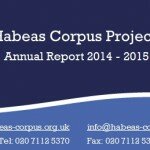Publications
Our first Annual Report now published!
It has been a challenging, emotional, exciting and ultimately very successful first year for the Habeas Corpus Project. We are proud to present to you all our very first Annual Report. Click below to download!
There was a point last year when we considered giving up, but thanks to the tremendous support and encouragement we received we are now stronger than ever and dedicated to continuing for many years to come. Thank you to all those who showed their support either by encouragement, donations or volunteering with us last year.
 Click the link to download the Habeas Corpus Project Annual Report 2014-2015
Click the link to download the Habeas Corpus Project Annual Report 2014-2015
September 2015: Academic Publications on Unlawful Detention
Recent updates on academic articles, books and reports from around the world on unlawful immigration detention. The following portfolio is compiled by Stephanie Silverman as part of the Detention Workshop, an academic discussion group on immigration detention.
BOOK: A new book from our colleague, César Cuauhtémoc García Hernández:
Written by the author of the crImmigration.com blog, Crimmigration Law maps the legal doctrine that comprises U.S. crimmigration law, including two chapters on detention. Part of the section on how criminal adjudications affect immigration proceedings, chapter 4 addresses legal authority regarding immigration detention and its limitations. In a later section on crimmigration enforcement mechanisms, chapter 9 highlights the detention system’s expansion and conditions before turning to alternatives to detention. More information is available at http://crimmigration.com/book/
ARTICLES (6):
1) Kagan, M. (2015). “Limiting Deterrence: Judicial Resistance to Detention of Asylum-Seekers in Israel and the United States.” Texas International Law Journal Scholarly Works: 1 – 23.
Governments have advanced the argument that asylum-seekers may be detained in order to deter other would be asylum-seekers from coming. But in recent litigation in the United States and Israel, this justification for mass detention met with significant resistance from courts. This Essay looks at the way the American and Israeli courts dealt with the proposed deterrence rationale for asylum-seeker detention. It suggests that general deterrence raises three sequential questions:
- Is deterrence ever legitimate as a stand alone justification for depriving people of liberty?
- If deterrence is sometimes legitimate, is it valid as a general matter in migration control, or is it limited to
certain exceptional circumstances?
- If deterrence is a legitimate goal, is there any effective proportionality limit on the measures a government may take against asylumseekers?
The American and Israeli courts did not answer these questions in the same way, and they did not foreclose all potential future uses of deterrence by their respective governments. But they signaled considerable judicial resistance, which may make it more difficult for governments to justify mass detention in the future.
See: http://scholars.law.unlv.edu/facpub/936/?utm_source=scholars.law.unlv.edu%2Ffacpub%2F936&utm_medium=PDF&utm_campaign=PDFCoverPages
2) Mullins, K. (2015). “Mandatory Detention: Why the Colloquial Name for INA Sec. 236(c) Is a Misnomer and How Alternatives to Detention Programs Can Fulfill Its Custody Requirement ” National Lawyers Guild Review 72(01): 34 – 54.
This article seeks to demonstrate, through careful examination and interpretation of INA § 236(c), that the Department of Homeland Security (DHS) could use existing Alternatives to Detention (ATD) programs and remain in perfect compliance with the statutory mandate, which clearly requires that DHS place noncitizens convicted of certain crimes into “custody.” Part I will briefly describe the legislative history of INA § 236(c) and explain the relevant statutory provisions. Parts II and III will examine Congress’s selective use of the terms “custody” and “detain,” both within INA § 236 specifically and within other related provisions of the INA. As Congress declined to define appropriately rely on principles of habeas corpus jurisprudence to conclude that “custody” as used in INA § 236(c) may be fulfilled by the use of ATD programs. Part V will examine recent agency precedent to show that the Board of Immigration Appeal’s (hereafter “Board”) holding in Matter ofAguilar- Aquino”0 that an electronic monitoring program did not constitute “custody” for purposes of 8 C.F.R. § 1236.1 (d)(1) does not require that outcome for the entirely separate mandatory custody provision at INA § 236(c). Instead, it xwill demonstrate how the 2008 decision of a Los Angeles IJ in Matter ofXI could be used as a model for the application of habeas corpus jurisprudence to define “custody” under INA § 236(c) as encompassing ATD programs. Part VI will show that in spite of legislative history suggesting that INA § 236(c) encompasses a “lock ’em up” approach to noncitizens convicted of crimes, recent ICE statistics and current proposed legislation reveal that the use of electronic monitoring furthers the intended purpose of the statutes.
3) Noferi, M. L. and R. Koulish (2015). “The Immigration Detention Risk Assessment.” Georgetown Immigration Law Journal 29: 45 – 93.
In early 2013, U.S. Immigration and Customs Enforcement (“ICE”) deployed nationwide a new automated risk assessment tool to help determine whether to detain or release noncitizens pending their deportation proceedings. Adapted from similar evidence-based criminal justice reforms that have reduced pretrial detention, ICE’s initiative now represents the largest pre-hearing risk assessment experiment in U.S. history — potentially impacting over 400,000 individuals per year. However, to date little information has been released regarding the risk assessment algorithm, processes, and outcomes.
This article provides the first comprehensive examination of ICE’s risk assessment initiative, based on public access to ICE methodology and outcomes as a result of Freedom of Information Act requests. This article argues that immigration risk assessment in its current form will not reduce current over-detention trends. The unique aspects of immigration enforcement, laws, and the impacted population will likely frustrate accurate calibration of the risk tool, and effective implementation of even a calibrated tool — in turn frustrating constructive impact of ICE’s risk assessment initiative on over-detention. Consequently, the immigration risk assessment may only add a scientific veneer to enforcement that remains institutionally predisposed towards detention and control.
Additionally, this article argues that even if more accurate, evidence-based immigration detention were achieved under a future risk assessment regime, it would nonetheless likely be accompanied by several disadvantages. Particularly, risk assessment could facilitate a transition from mass detention to mass supervision of an even wider net of supervisees, by justifying lesser deprivations of liberty such as electronic supervision.
See: http://papers.ssrn.com/sol3/papers.cfm?abstract_id=2635247
4) Podkul, J. (2015). Detention and Treatment of Unaccompanied Migrant Children at the U.S.-Mexico Border. Childhood and Migration in Central and North America: Causes, Policies, Practices and Challenges. R. Katz and J. Kelsey. California, Center for Gender & Refugee Studies, UC Hastings.
See:http://cgrs.uchastings.edu/sites/default/files/14_WRC_Border_English_0.pdf
5) Puthoopparambil, S. J., et al. (2015). “Quality of life among immigrants in Swedish immigration detention centres: a cross-sectional questionnaire study.” Global Health Action 8: 1 – 10.
Background: Detention of immigrants negatively affects their health and well-being. Quality of life (QOL) is a broad concept incorporating the self-evaluation of one’s own health and well-being that can provide an understanding of the health and well-being of immigrant detainees. The aim of this study was to estimate QOL among immigrant detainees in Sweden and to assess its relationship with the services provided in detention centres and with the duration of detention.
Design: All immigrants in all five existing Swedish detention centres (N193) were invited to participate in the study (n127). In this cross-sectional study, QOL was measured using the WHOQOL-BREF questionnaire, which was administered by the first author. The questionnaire contained four additional
questions measuring participants’ satisfaction with the services provided in detention. Associations between QOL domain scores and service satisfaction scores were assessed using regression analysis. The Spearman’s rank correlation coefficient was calculated to measure the degree of association between the duration of
detention and QOL scores.
Results: The mean QOL domain scores (out of 100) were 47.0, 57.5, 41.9, and 60.5 for the environmental, physical, psychological, and social domains, respectively. The level of support detainees received from detention staff was significantly positively associated with detainees’ physical (badjusted 3.93, confidence interval [CI] 0.067.80) and psychological (badjusted 5.72, CI 1.779.66) domain scores. There was also significant positive between detainees’ satisfaction with the care they received from detention staff and the domain scores. The general health score in the WHOQOL-BREF was significantly associated with the detainees’ ability to understand the Swedish or English languages. Although not statistically significant, a longer duration of detention was negatively correlated with QOL scores.
Conclusion: Immigrant detainees report low QOL. Services provided at the centres, especially the support received from detention staff, is positively associated with their QOL. A review of detention guidelines addressing language barriers, staff training, and duration of detention is highly recommended.
See: http://www.globalhealthaction.net/index.php/gha/article/view/28321/pdf_94
April 2015: Academic Publications on Unlawful Detention
Recent updates on academic articles, books and reports from around the world on unlawful immigration detention. The following portfolio is compiled by Stephanie Silverman as part of the Detention Workshop, an academic discussion group on immigration detention.
January 2015: Academic Publications on Unlawful Detention
Our first of regular updates on recent academic articles from around the world on unlawful immigration detention. The following portfolio is compiled by Stephanie Silverman as part of the Detention Workshop, an academic discussion group on immigration detention.
Anderson, S. and J. Ferng (2014). “No Boat: Christmas Island and the Architecture of Detention.” Architectural Theory Review 18 (02): 212 – 226.
This article uses Christmas Island as a site to discuss the contested history of Australian immigration in terms of the built environment. Offshore detention centres and the political systems for detaining asylum seekers pose substantial demands of institutional design, control of populations, and psychic anxieties associated with the arrival of foreigners. Systems of detention are explored through the topics of territory, human labour, boats as visual signs, and the buildings constructed to house detainees. Entangled orders of security expose detention as a timely subject for architectural intervention and commentary.
Athwal, H. (2015). “‘I don’t have a life to live’: deaths and UK detention.” Race & Class 56 (03): 50 – 68.
The Institute of Race Relations has over the last twenty-three years been monitoring the 508 deaths in custody in suspicious circumstances of individuals from BME, migrant and refugee communities, which rarely make the headlines and for which no person is ever convicted (to be published as the report Dying for Justice). Here, in an extract, the author examines the culture of racism and the impact of privatisation and sub-contracting in the detention and deportation of ‘failed’ asylum seekers. In case after case it exposes how the vulnerable, mentally- and physically-ill are neglected – leading to deaths by self-harm and inadequate treatment. The death during deportation of Joy Gardner, which involved disproportionate and reckless use of force, is examined in depth. The use of equipment of control for those who are clearly fearful of being forcibly returned, remains a vexed issue.
Cabot, J. A. (2014). “Problems Faced by Mexican Asylum Seekers in the United States.” Journal on Migration and Human Security 2(04): 361 – 377.
Violence in Mexico rose sharply in response to President Felipe Calderón’s military campaign against drug cartels which began in late 2006. As a consequence, the number of Mexicans who have sought asylum in the United States has grown significantly. In 2013, Mexicans made up the second largest group of defensive asylum seekers (those in removal proceedings) in the United States, behind only China (EOIR 2014b). Yet between 2008 and 2013, the grant rate for Mexican asylum seekers in immigration court fell from 23 percent to nine percent (EOIR 2013, 2014b).
This paper examines—from the perspective of an attorney who represented Mexican asylum seekers on the US-Mexico border in El Paso, Texas—the reasons for low asylum approval rates for Mexicans despite high levels of violence in and flight from Mexico from 2008 to 2013. It details the obstacles faced by Mexican asylum seekers along the US-Mexico border, including placement in removal proceedings, detention, evidentiary issues, narrow legal standards, and (effectively) judicial notice of country conditions in Mexico. The paper recommends that asylum seekers at the border be placed in affirmative proceedings (before immigration officials), making them eligible for bond. It also proposes increased oversight of immigration judges.
Noferi, M. L. (2014). “Making Civil Immigration Detention ‘Civil,’ and Examining the Emerging U.S. Civil Detention Paradigm.” Journal of Civil Rights & Economic Development 27: 101 – 154.
In 2009, the Obama Administration began to reform its sprawling immigration detention system by asking the question, “How do we make civil detention civil?” Five years later, after opening an explicitly-named “civil detention center” in Texas to public criticism from both sides, the Administration’s efforts have stalled. But its reforms, even if fully implemented, would still resemble lower-security criminal jails.
This symposium article is the first to comprehensively examine the Administration’s efforts to implement “truly civil” immigration detention, through new standards, improved conditions, and greater oversight. It does so by undertaking the first descriptive comparison of the U.S.’s two largest civil detention systems — immigration detention and sex offender civil commitment — to ascertain the value of the “civil” label of detention reform. It finds the emerging civil detention paradigm to be an incarcerative model presuming round-the-clock confinement but with lower security, as well as increasing, near-criminal procedural protections. Thus, the “civil” label of reform has little meaning, either to the individual’s deprivation of liberty or the expressive message communicated. More meaningful and more “civil” reform would be to implement a system that detains less, not just better. Looking forward, I offer a prescriptive framework for a civil detention system — one that detains far less frequently, for shorter periods, and in non-secure facilities not constituting “detention” as traditionally conceived.
Forthcoming Publications
We are currently communicating with academics, NGO’s and other organisations to find relevant research, reports and statistics relating to unlawful detention in the UK and abroad. We aim to publish such work on our website with the consent and co-operation of the authors. We further hope to commission research in to specific areas of unlawful detention in the future and publish findings on this website.






